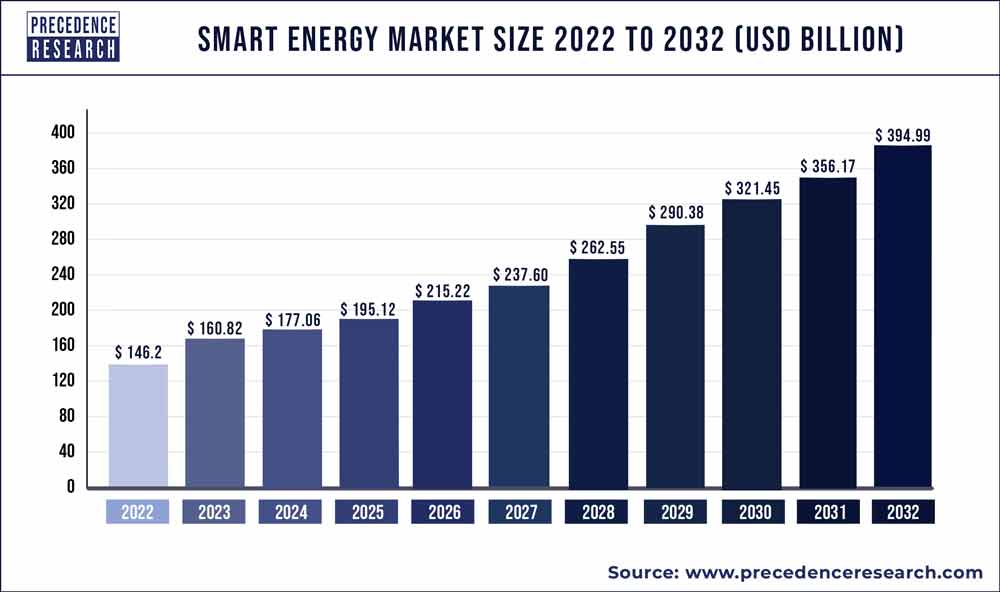Smart Energy Market Size To Attain USD 394.99 Billion By 2032
The global smart energy market size was valued at USD 160.82 billion in 2023 and is expected to hit around USD 394.99 billion by 2032, growing a CAGR of 10.50% from 2023 to 2032.

Key Takeaways
- North America contributed more than 42% of revenue share in 2022.
- Asia Pacific is estimated to expand the fastest CAGR between 2023 and 2032.
- By product, the smart grid segment has held the largest market share of 39% in 2022.
- By product, the smart solar segment is anticipated to grow at a remarkable CAGR of 14.1% between 2023 and 2032.
- By end-use industry, the Industrial segment generated over 57% of revenue share in 2022.
- By end-use industry, the commercial segment is expected to expand at the fastest CAGR over the projected period.
The smart energy market is a dynamic sector characterized by the integration of advanced technologies to optimize the generation, distribution, and consumption of energy. This market encompasses a wide range of innovations, including smart grids, energy storage solutions, and demand response systems. Smart energy systems leverage real-time data and analytics to enhance efficiency, reduce carbon footprint, and ensure a reliable and sustainable energy supply. The growing adoption of renewable energy sources, coupled with advancements in smart grid infrastructure, is a key driver for the expansion of the smart energy market.
One of the significant growth factors in this market is the increasing global focus on sustainable and eco-friendly energy solutions. Governments and businesses worldwide are recognizing the importance of transitioning towards cleaner energy sources to address environmental concerns and mitigate the impact of climate change. This shift towards sustainability is driving investments in smart energy technologies, fostering innovation, and creating opportunities for market growth.
Moreover, the rise of smart cities and the Internet of Things (IoT) is contributing to the expansion of the smart energy market. The interconnectedness of devices and systems allows for seamless communication and control, enabling more efficient energy management. Smart meters, sensors, and automation play crucial roles in optimizing energy use, reducing waste, and enhancing overall system reliability.
Get a Sample: https://www.precedenceresearch.com/sample/3555
Smart Energy Market Scope
| Report Coverage | Details |
| Growth Rate from 2023 to 2032 | CAGR of 10.50% |
| Market Size in 2023 | USD 160.82 Billion |
| Market Size by 2032 | USD 394.99 Billion |
| Largest Market | North America |
| Base Year | 2022 |
| Forecast Period | 2023 to 2032 |
| Segments Covered | By Product and By End-User Industry |
| Regions Covered | North America, Europe, Asia-Pacific, Latin America, and Middle East & Africa |
By Product:
- Smart grid
- Digital Oilfield
- Smart Solar
- Home Energy Management System
- Others
The Smart Energy Market encompasses a diverse range of products aimed at optimizing energy usage and efficiency. Smart meters stand as a cornerstone, offering real-time data on energy consumption. These devices enable consumers and utilities to make informed decisions, leading to better resource management. Smart grids play a pivotal role by integrating advanced communication and control technologies into traditional power grids. Energy storage solutions, such as advanced batteries, contribute to balancing supply and demand, fostering a more stable and resilient energy infrastructure.
By End-User Industry:
- Residential
- Industrial
- Commercial
The application of smart energy solutions extends across various industries, each with its unique set of challenges and opportunities. In the residential sector, smart home technologies enable homeowners to monitor and control their energy consumption remotely, fostering a culture of sustainability. In commercial and industrial settings, smart energy systems enhance operational efficiency, reduce costs, and contribute to sustainability goals. The transportation sector is undergoing a transformation with the rise of electric vehicles and intelligent charging infrastructure. Additionally, smart energy technologies are increasingly adopted in healthcare, education, and government sectors, showcasing the broad and transformative impact of these innovations across diverse industries.
Read Also: Skincare Market Will be USD 284.97 Million by 2032
Recent Developments
- In 2022, GE Digital has unveiled a Distributed Energy Resource Management System (DERMS) solution, contributing to a safer, secure, and resilient electric grid. The software integrates intelligence, operations, economics, and markets in a unified platform, empowering grid operators to efficiently manage and optimize Distributed Energy Resources (DERs) for clean, reliable, and affordable energy delivery.
- In 2022, GE Renewable Energy has secured orders from Continuum Green Energy Limited for 81 units of its 2.7-132 onshore wind turbines. The turbines, totaling 218.70 MW, will be installed across wind power projects in Tamil Nadu and Madhya Pradesh, India.
- In 2022, Itron is expanding its collaboration with Microsoft to accelerate the energy transition. The partnership merges Itron’s energy management solutions with Microsoft’s cloud offerings, revolutionizing how users perceive and manage energy. Together, they aim to provide utilities with innovative solutions, promoting grid resilience, consumer engagement, operational efficiency, and decarbonization.
Smart Energy Market Players
- General Electric Company
- Siemens AG
- ABB Ltd.
- Cisco Systems, Inc.
- IBM Corporation
- Honeywell International Inc.
- Schneider Electric SE
- Siemens Gamesa Renewable Energy
- Itron, Inc.
- Trilliant Holdings, Inc.
- Landis+Gyr Group AG
- Eaton Corporation
- Schweitzer Engineering Laboratories, Inc.
- C3.ai, Inc.
- Enphase Energy, Inc.
Segments Covered in the Report
By Product
- Smart grid
- Digital Oilfield
- Smart Solar
- Home Energy Management System
- Others
By End-User Industry
- Residential
- Industrial
- Commercial
By Geography
- North America
- Europe
- Asia-Pacific
- Latin America
- Middle East and Africa
TABLE OF CONTENT
Chapter 1. Introduction
1.1. Research Objective
1.2. Scope of the Study
1.3. Definition
Chapter 2. Research Methodology (Premium Insights)
2.1. Research Approach
2.2. Data Sources
2.3. Assumptions & Limitations
Chapter 3. Executive Summary
3.1. Market Snapshot
Chapter 4. Market Variables and Scope
4.1. Introduction
4.2. Market Classification and Scope
4.3. Industry Value Chain Analysis
4.3.1. Raw Material Procurement Analysis
4.3.2. Sales and Distribution Channel Analysis
4.3.3. Downstream Buyer Analysis
Chapter 5. COVID 19 Impact on Smart Energy Market
5.1. COVID-19 Landscape: Smart Energy Industry Impact
5.2. COVID 19 – Impact Assessment for the Industry
5.3. COVID 19 Impact: Global Major Government Policy
5.4. Market Trends and Opportunities in the COVID-19 Landscape
Chapter 6. Market Dynamics Analysis and Trends
6.1. Market Dynamics
6.1.1. Market Drivers
6.1.2. Market Restraints
6.1.3. Market Opportunities
6.2. Porter’s Five Forces Analysis
6.2.1. Bargaining power of suppliers
6.2.2. Bargaining power of buyers
6.2.3. Threat of substitute
6.2.4. Threat of new entrants
6.2.5. Degree of competition
Chapter 7. Competitive Landscape
7.1.1. Company Market Share/Positioning Analysis
7.1.2. Key Strategies Adopted by Players
7.1.3. Vendor Landscape
7.1.3.1. List of Suppliers
7.1.3.2. List of Buyers
Chapter 8. Global Smart Energy Market, By Product
8.1. Smart Energy Market, by Product, 2023-2032
8.1.1. Smart grid
8.1.1.1. Market Revenue and Forecast (2020-2032)
8.1.2. Digital Oilfield
8.1.2.1. Market Revenue and Forecast (2020-2032)
8.1.3. Smart Solar
8.1.3.1. Market Revenue and Forecast (2020-2032)
8.1.4. Home Energy Management System
8.1.4.1. Market Revenue and Forecast (2020-2032)
8.1.5. Others
8.1.5.1. Market Revenue and Forecast (2020-2032)
Chapter 9. Global Smart Energy Market, By End-User Industry
9.1. Smart Energy Market, by End-User Industry, 2023-2032
9.1.1. Residential
9.1.1.1. Market Revenue and Forecast (2020-2032)
9.1.2. Industrial
9.1.2.1. Market Revenue and Forecast (2020-2032)
9.1.3. Commercial
9.1.3.1. Market Revenue and Forecast (2020-2032)
Chapter 10. Global Smart Energy Market, Regional Estimates and Trend Forecast
10.1. North America
10.1.1. Market Revenue and Forecast, by Product (2020-2032)
10.1.2. Market Revenue and Forecast, by End-User Industry (2020-2032)
10.1.3. U.S.
10.1.3.1. Market Revenue and Forecast, by Product (2020-2032)
10.1.3.2. Market Revenue and Forecast, by End-User Industry (2020-2032)
10.1.4. Rest of North America
10.1.4.1. Market Revenue and Forecast, by Product (2020-2032)
10.1.4.2. Market Revenue and Forecast, by End-User Industry (2020-2032)
10.2. Europe
10.2.1. Market Revenue and Forecast, by Product (2020-2032)
10.2.2. Market Revenue and Forecast, by End-User Industry (2020-2032)
10.2.3. UK
10.2.3.1. Market Revenue and Forecast, by Product (2020-2032)
10.2.3.2. Market Revenue and Forecast, by End-User Industry (2020-2032)
10.2.4. Germany
10.2.4.1. Market Revenue and Forecast, by Product (2020-2032)
10.2.4.2. Market Revenue and Forecast, by End-User Industry (2020-2032)
10.2.5. France
10.2.5.1. Market Revenue and Forecast, by Product (2020-2032)
10.2.5.2. Market Revenue and Forecast, by End-User Industry (2020-2032)
10.2.6. Rest of Europe
10.2.6.1. Market Revenue and Forecast, by Product (2020-2032)
10.2.6.2. Market Revenue and Forecast, by End-User Industry (2020-2032)
10.3. APAC
10.3.1. Market Revenue and Forecast, by Product (2020-2032)
10.3.2. Market Revenue and Forecast, by End-User Industry (2020-2032)
10.3.3. India
10.3.3.1. Market Revenue and Forecast, by Product (2020-2032)
10.3.3.2. Market Revenue and Forecast, by End-User Industry (2020-2032)
10.3.4. China
10.3.4.1. Market Revenue and Forecast, by Product (2020-2032)
10.3.4.2. Market Revenue and Forecast, by End-User Industry (2020-2032)
10.3.5. Japan
10.3.5.1. Market Revenue and Forecast, by Product (2020-2032)
10.3.5.2. Market Revenue and Forecast, by End-User Industry (2020-2032)
10.3.6. Rest of APAC
10.3.6.1. Market Revenue and Forecast, by Product (2020-2032)
10.3.6.2. Market Revenue and Forecast, by End-User Industry (2020-2032)
10.4. MEA
10.4.1. Market Revenue and Forecast, by Product (2020-2032)
10.4.2. Market Revenue and Forecast, by End-User Industry (2020-2032)
10.4.3. GCC
10.4.3.1. Market Revenue and Forecast, by Product (2020-2032)
10.4.3.2. Market Revenue and Forecast, by End-User Industry (2020-2032)
10.4.4. North Africa
10.4.4.1. Market Revenue and Forecast, by Product (2020-2032)
10.4.4.2. Market Revenue and Forecast, by End-User Industry (2020-2032)
10.4.5. South Africa
10.4.5.1. Market Revenue and Forecast, by Product (2020-2032)
10.4.5.2. Market Revenue and Forecast, by End-User Industry (2020-2032)
10.4.6. Rest of MEA
10.4.6.1. Market Revenue and Forecast, by Product (2020-2032)
10.4.6.2. Market Revenue and Forecast, by End-User Industry (2020-2032)
10.5. Latin America
10.5.1. Market Revenue and Forecast, by Product (2020-2032)
10.5.2. Market Revenue and Forecast, by End-User Industry (2020-2032)
10.5.3. Brazil
10.5.3.1. Market Revenue and Forecast, by Product (2020-2032)
10.5.3.2. Market Revenue and Forecast, by End-User Industry (2020-2032)
10.5.4. Rest of LATAM
10.5.4.1. Market Revenue and Forecast, by Product (2020-2032)
10.5.4.2. Market Revenue and Forecast, by End-User Industry (2020-2032)
Chapter 11. Company Profiles
11.1. General Electric Company
11.1.1. Company Overview
11.1.2. Product Offerings
11.1.3. Financial Performance
11.1.4. Recent Initiatives
11.2. Siemens AG
11.2.1. Company Overview
11.2.2. Product Offerings
11.2.3. Financial Performance
11.2.4. Recent Initiatives
11.3. ABB Ltd.
11.3.1. Company Overview
11.3.2. Product Offerings
11.3.3. Financial Performance
11.3.4. Recent Initiatives
11.4. Cisco Systems, Inc.
11.4.1. Company Overview
11.4.2. Product Offerings
11.4.3. Financial Performance
11.4.4. Recent Initiatives
11.5. IBM Corporation
11.5.1. Company Overview
11.5.2. Product Offerings
11.5.3. Financial Performance
11.5.4. Recent Initiatives
11.6. Honeywell International Inc.
11.6.1. Company Overview
11.6.2. Product Offerings
11.6.3. Financial Performance
11.6.4. Recent Initiatives
11.7. Schneider Electric SE
11.7.1. Company Overview
11.7.2. Product Offerings
11.7.3. Financial Performance
11.7.4. Recent Initiatives
11.8. Siemens Gamesa Renewable Energy
11.8.1. Company Overview
11.8.2. Product Offerings
11.8.3. Financial Performance
11.8.4. Recent Initiatives
11.9. Itron, Inc.
11.9.1. Company Overview
11.9.2. Product Offerings
11.9.3. Financial Performance
11.9.4. Recent Initiatives
11.10. Trilliant Holdings, Inc.
11.10.1. Company Overview
11.10.2. Product Offerings
11.10.3. Financial Performance
11.10.4. Recent Initiatives
Chapter 12. Research Methodology
12.1. Primary Research
12.2. Secondary Research
12.3. Assumptions
Chapter 13. Appendix
13.1. About Us
13.2. Glossary of Terms
Contact Us:
Mr. Alex
Sales Manager
Call: +1 9197 992 333
Email: sales@precedenceresearch.com
Web: https://www.precedenceresearch.com
Blog: https://www.expresswebwire.com/
Blog: https://www.uswebwire.com/
Blog: https://www.dailytechbulletin.com/
Blog: https://www.autoindustrybulletin.com/

